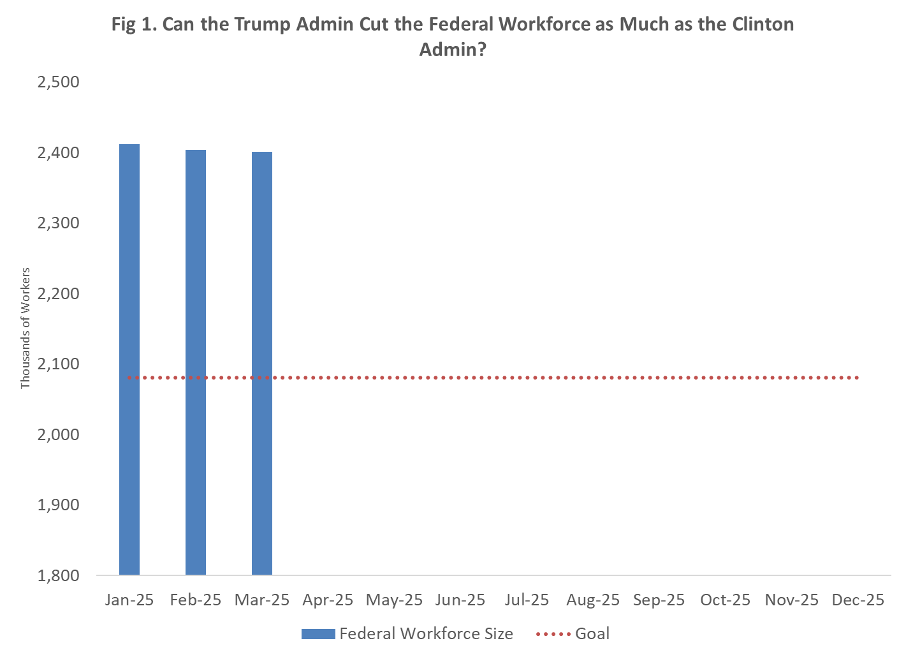March was marked by a turbulent series of layoffs and reinstatements as federal agencies and judges reversed each other’s actions. This is the second Bureau of Labor Statistics (BLS) report to capture at least some of these changes since the new administration issued Executive Order (EO) 14210 on “Reforming the Federal Workforce to Better Serve Americans.”
Before digging into the numbers, it is important to recognize that the BLS Current Employment Statistics report does not cover data all the way up to the end of the month. Instead, it is based on data collected during the reference week, which is typically the week that includes the 12th day of the month. For example, the latest report (March) primarily reflects employment data from the week of March 10–14, 2025. Any job changes occurring after that week—such as layoffs—will not be captured in that report but may appear in subsequent revisions or the next month’s report.
As of March 2025, there were exactly three million federal government workers, excluding active military personnel. However, 599,500 of those workers were Postal Service employees. Excluding Postal Service workers, there were 2.401 million federal government workers. This is a decline of just 3,200 from last month (although last month’s numbers were revised down to a decline of 8,600), and a total decline in the federal workforce of 11,900 this year.
At the start of the month, the Veterans Affairs (VA) Chief of Staff Christopher Syrek set a goal to return VA staffing to 2019 levels of 399,957. This goal would require terminating the roles of at least 76,000 federal workers from the VA.
On March 7, the Department of Health and Human Services (HHS) offered employees voluntary separation incentive payments with the option to resign in exchange for a $25,000 payment. Employees were given until March 14, by which time some 10,000 HHS employees resigned voluntarily.
In addition to the 10,000 HHS employees who left voluntarily by March 14, an additional 10,000 workers were let go by agencies that operate under the HHS, including the FDA, CDC, and NIH.
On March 11, the Department of Education terminated 1,315 workers. These workers are due to receive full pay and benefits through March 21 and will then be placed on administrative leave with pay through June 9. As these workers are still on payrolls through June, they will not show up in the latest BLS jobs data.
Challenging DOGE efforts to reduce the size of the federal workforce, District Judge James Bredar ordered the mass reinstatement of 24,813 fired probationary workers at 18 federal agencies. In response, the government moved to reinstate 15,499 probationary employees (5,925 workers were previously offered reinstatement before the order) on March 17.
On March 20, the President issued a memorandum expanding the power of OPM to terminate federal employees based on “post-appointment conduct.” Traditionally, OPM only has the authority to remove an employee during the probationary year. This memo broadens that authority, allowing OPM to terminate federal workers beyond the probationary period.
On March 24, the government asked the Supreme Court to halt the order of U.S. District Judge Bredar to rehire almost 16,000 probationary workers.
As noted in previous updates, some efforts to reduce the federal workforce such as the Deferred Resignation Program will not be visible in job reports data. This is because workers are still receiving pay and benefits through September and are therefore classified as employed under BLS guidelines.
Can DOGE Efforts Match the Clinton Administration’s Achievements in Shrinking the Federal Workforce?
If the Trump administration is serious about meaningfully reducing the size of the federal workforce, then it should aim to reduce the number of federal employees at least by the same amount that the Clinton administration did in the four years between 1993 and 1997. This goal would require shrinking the federal workforce to fewer than 2.08 million workers by 2028, as I show in the tracker chart below.
To monitor the progress of DOGE’s federal workforce reduction efforts, I will update this tracker series monthly. This series of posts will include tracking workforce reductions, agency restructuring efforts, and any new policies or developments related to these initiatives. Stay tuned for regular updates on the Trump administration’s progress toward achieving its workforce reduction goals.





